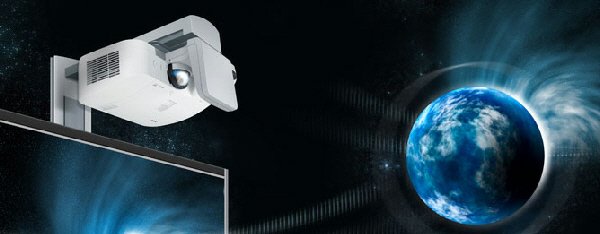
3D is big news at the moment with most of the latest blockbusters from the likes of Steven Spielberg, and James Cameron embracing the technology to bring their creations to a new depth of reality. For 3D for education, Texas Instruments and NEC have created a genuine high quality viewing experience that is simple to operate and integrate into teaching.
What is 3D for Education?
By delivering alternate images to each eye, the brain is tricked into seeing an object from a third perspective. The quality of the 3D images will depend upon the skill with which the images have been created and, of course, through the quality of the projector. Through high quality media and playback, an absorbing experience is created that is ideal for capturing the imagination of students. With a good standard of 3D content, it is easier for the viewer to understand an objects dimensions and obtain a greater feel for how close or far away it is. As 3D for education can present more information in an easy means for the viewer, then learning can be accelerated and the experience made more rewarding.
3D for education works by delivering slightly different images to each eye alternately with an image update rate sufficiently fast (120Hz) that the viewer only perceives a simultaneous image. The best 3D would mean viewers are free to watch a TV or projected image with the naked eye but such technology is, as yet, less reliable and very much more expensive. For a quality experience then using glasses that filter the images to each eye provide a reliable image and spatial awareness.
Low cost Anaglyph viewing is not a new system, indeed it’s been out many times over the years when 3D has made an appearance, but it is simple and affordable. It works with different coloured filters for each eye to separate the images and trick the human brain into re-creating that image in three dimensions. The system is quick to set up and, should a pair of glasses get broken or lost, then it is not the end of the World!

3D for education has recently been enabled with affordable active shutter glasses that are beginning to set standards for quality images. NEC pioneer 3D DLP® Link projection is their latest 3D for education projector. LCD shutter glasses use liquid crystals to make each lens either transparent or opaque to separate the images in alternate order.
HDMI 1.4A 3D specification can handle all popular 3D signal formats and so set up between the source and display have become ‘plug and play’. Though it is worth noting that the display source such as a PC will need to be of a good specification to properly power a 3D display.
The applications of 3D for education are wide and could include applications for biology, physics, chemistry or the arts. NEC 3D ready value and ultra-short projectors, together with the NEC 3D starter kit represent the ideal introduction for the classroom. This simple, PC based system includes the projector, viewing glasses, 3D player and 3D media. Working with Texas Instruments, NEC have 3D for education initiatives going into classrooms across Europe.
NEC is leading the way with high quality 3D theatre systems and this technology is now available for cost effective 3D for education.
For more information on 3D for education then please contact SchoolCare.
SchoolCare – one of the South of England’s leading provider of ICT services to education.
Areas covered include Bedfordshire, Berkshire, Buckinghamshire, Cornwall, Devon, Dorset, Essex, Gloucestershire, Hampshire, Hertfordshire, Kent, London, Oxfordshire, Somerset, Suffolk, Surrey and West Sussex, East Sussex and Wiltshire.



